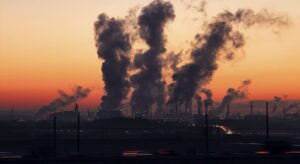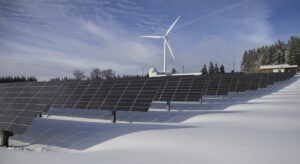Nuclear power plant (NPP) – a power plant in which atomic (nuclear) energy is converted into electrical energy. The generator of energy at the NPP is a nuclear reactor. The heat that is released in the reactor as a result of the chain fission reaction of some heavy element nuclei is then converted into electricity, just like in conventional thermal power plants (TPPs). Unlike thermal power plants using fossil fuel, nuclear power plants use nuclear fuel (mainly 233U, 235U, 239Pu).
During fission of 1 g of uranium or plutonium isotopes 22 500 kWh is released, which is equivalent to the energy contained in 2800 kg of fuel equivalent. It has been established that the world’s energy resources of nuclear fuel (uranium, plutonium, etc.) significantly exceed the energy resources of natural reserves of fossil fuels (oil, coal, natural gas, etc.). This opens up vast prospects for meeting the rapidly growing needs for fuel. In addition, it is necessary to take into account the increasing consumption of coal and oil for technological purposes of the world chemical industry, which is becoming a serious competitor to thermal power plants.
Despite the discovery of new deposits of fossil fuels and improvement of the methods of their extraction, there is a tendency to a relative increase in their cost in the world. This creates the most difficult conditions for countries with limited reserves of fossil fuels. There is an obvious need for the rapid development of nuclear power, which already occupies a prominent place in the energy balance of several industrial countries.
Heat emitted in the reactor core is taken by the water (coolant) of the 1st circuit, which is pumped through the reactor by the main circulation pump. The heated water from the reactor enters the heat exchanger (steam generator), where it transfers the heat received in the reactor to the water of the 2nd circuit. The water of the 2nd circuit evaporates in the steam generator and the resulting steam enters the turbine. There are 4 types of thermal neutron reactors most commonly used at NPPs:
Water-water reactors with water as moderator and coolant;
Graphite-water reactors with a water coolant and a graphite moderator;
heavy-water with a water coolant and heavy water as a moderator;
graphite-gas with a gas coolant and a graphite moderator.
The choice of the reactor type to be used is mainly determined by the accumulated experience in reactor engineering, as well as by the availability of the necessary industrial equipment, raw material reserves, etc. Water-water reactors are most commonly used at U.S. nuclear power plants. Graphite-gas reactors are used in England. Nuclear power plants in Canada are dominated by NPPs with heavy-water reactors. Depending on the type and aggregate state of the coolant, one or another thermodynamic cycle of NPP is created.
Selection of the upper temperature limit of thermodynamic cycle is determined by the maximum permissible temperature of fuel element cladding (FEC) containing nuclear fuel, permissible temperature of nuclear fuel itself, as well as the properties of coolant, adopted for this type of reactor. At NPPs with water-cooled thermal reactors, low-temperature steam cycles are usually used. Reactors with a gas coolant allow the use of relatively more economical water steam cycles with higher initial pressure and temperature.
Heat scheme of NPP in these two cases is executed as 2-circuit: in the 1st circuit the coolant circulates, the 2nd circuit is a steam-water circuit. In case of reactors with boiling water or high-temperature gas coolant, a single-circuit thermal NPP is possible. In boiling water reactors, water boils in the core, the resulting steam-water mixture is separated, and saturated steam is sent either directly to the turbine or preliminarily returned to the core for superheating; in high-temperature graphite-gas reactors, a conventional gas-turbine cycle can be used. In this case, the reactor acts as a combustion chamber. During reactor operation, the concentration of fissile isotopes in the nuclear fuel gradually decreases, i.e. fuel rods burn out, so they are eventually replaced with fresh ones. Nuclear fuel is reloaded using remotely operated mechanisms and devices.
The spent fuel rods are transferred to the decay pool and then sent for reprocessing. The reactor and its service systems include: the reactor itself with biological protection, heat exchangers, pumps or gas blowers that circulate coolant, pipelines and fittings of the circulation circuit, devices for reloading the nuclear fuel, special ventilation systems, emergency cooldown, etc.


